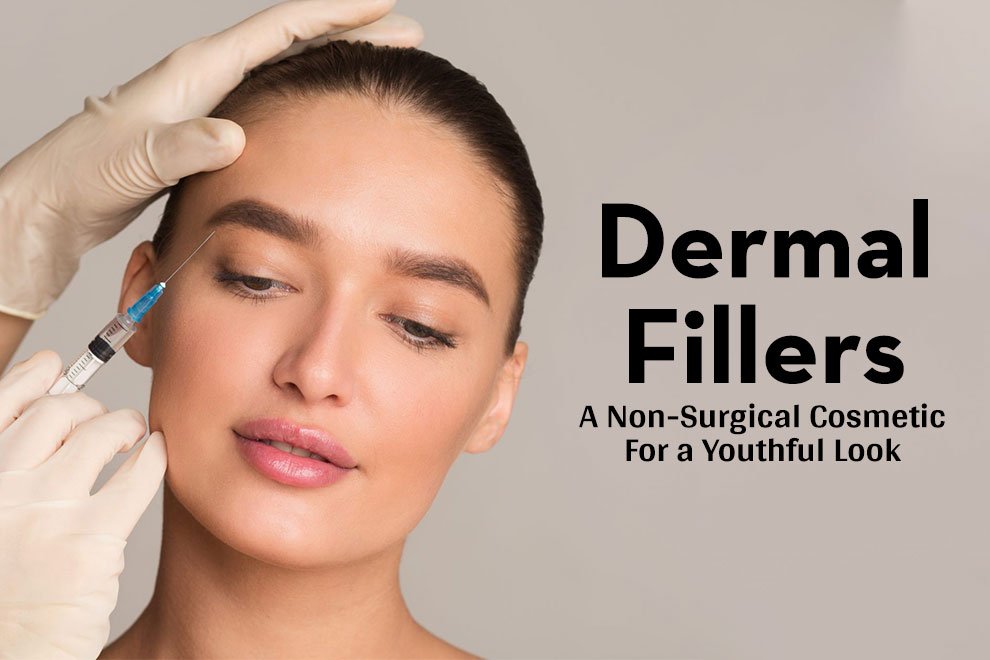What Are Dermal Fillers?
Dermal fillers are gel-like substances injected beneath the skin to restore volume, smooth wrinkles, and enhance facial features. The soft tissue fillers are an excellent option for those seeking a more youthful appearance without surgery. Injectable dermal fillers will address moderate to severe facial wrinkles and folds, significantly improving the skin’s texture and contour. Whether aiming to reduce nasolabial folds, smooth crow’s feet, or enhance lip volume, many individuals find these treatments effective for achieving their aesthetic goals.
Several injectable dermal fillers are available, with hyaluronic acid fillers being among the most popular. The fillers replenish the skin’s natural hyaluronic acid, which diminishes with age, leading to volume loss and wrinkles. When cosmetic surgeons inject dermal fillers, they will precisely target areas needing improvement, ensuring a natural and balanced result.
A dermal filler treatment will be customized to address specific concerns, from moderate to severe wrinkles, offering a minimally invasive solution to facial aging. The approach allows individuals to rejuvenate their appearance with minimal downtime and long-lasting results.
The Power of Hyaluronic Acid
Hyaluronic acid fillers are the most commonly used injectable fillers. Hyaluronic acid is a naturally occurring substance in the skin that helps keep it plump and hydrated. Over time, the skin loses hyaluronic acid, leading to volume loss and the formation of wrinkles. Hyaluronic acid fillers will replenish this lost volume and smooth lines, providing a natural appearance.
Types of Dermal Fillers
There are various types of dermal fillers, each with unique properties and benefits:
- Hyaluronic Acid (HA) Fillers: Known for their versatility and natural results. Brands like Juvederm and Restylane are popular options.
- Calcium Hydroxylapatite (CaHA) Fillers: A mineral-like compound that stimulates collagen production. Radiesse is a well-known CaHA filler.
- Poly-L-Lactic Acid Fillers: These stimulate the skin’s collagen production over time. Sculptra is a common choice.
- Polymethylmethacrylate (PMMA) Fillers: Considered semi-permanent fillers, offering long-lasting results. Bellafill is an example.
Benefits of Dermal Fillers
Dermal fillers offer a range of benefits:
- Restores Volume: Adds volume to areas like cheeks and lips, which tend to lose fullness with age.
- Smooths Wrinkles: Reduces the appearance of facial wrinkles, including frown lines, crow’s feet, and nasolabial folds.
- Enhances Facial Features: Improves facial features such as jawline and chin, offering a more defined look.
- Minimally Invasive: An outpatient procedure with minimal downtime compared to traditional plastic surgery.
- Stimulates Collagen Production: Certain fillers stimulate the body’s own collagen production, offering longer-lasting results.
Dermal Filler Procedures
Dermal filler procedures are typically quick, taking about 15 to 60 minutes depending on the treatment area. The process involves the following steps:
- Consultation: Discuss goals and concerns with a cosmetic surgeon.
- Preparation: The injection site is cleaned, and a topical anesthetic may be applied.
- Injection: The filler is injected beneath the skin, with the cosmetic surgeon carefully molding the filler to achieve the desired result.
- Post-Treatment Care: Mild swelling or bruising may occur but usually subsides within a few days. Follow any aftercare instructions provided.
Common Treatment Areas
Dermal fillers will address various concerns:
- Facial Wrinkles: Smooth deeper wrinkles and fine lines.
- Lip Augmentation: Add volume and shape to thin lips.
- Cheek Enhancement: Restore volume to sunken cheeks.
- Nasolabial Folds and Marionette Lines: Fill in lines that run from the nose to the mouth and chin.
- Acne Scars and Recessed Scars: Improve the appearance of scars.
- Facial Fat Loss: Counteract the effects of facial fat loss associated with aging.
Potential Risks and Considerations
Like any medical procedure, there are potential risks associated with dermal fillers:
- Swelling and Bruising: Common side effects that usually resolve within a few days.
- Infection: Rare but possible; hence, it is important to choose a qualified professional.
- Lumps and Bumps: Can occur but are usually temporary.
- Allergic Reactions: Rare but possible, particularly with certain filler materials.
- Tissue Death: Extremely rare but may occur if filler obstructs blood flow.
Choosing the Right Professional
Selecting a qualified and experienced cosmetic surgeon or dermatologist is crucial for achieving optimal results. Ensure they are board-certified and have a proven track record with dermal filler treatments.
Conclusion
Dermal fillers offer a versatile and effective solution for those looking to enhance their appearance without surgery. Whether it’s smoothing wrinkles, restoring volume, or enhancing facial features, dermal fillers provide a natural and youthful look. Always consult with a qualified professional to ensure safe and satisfactory results.
Frequently Asked Questions
How long do hyaluronic acid fillers last?
Hyaluronic acid fillers typically last between 6 to 18 months, depending on the treatment area and product used.
Are dermal fillers FDA-approved?
Yes, many dermal fillers, including hyaluronic acid fillers, are FDA-approved for safety and effectiveness.
Can dermal fillers be used to treat smile lines?
Yes, dermal fillers are commonly used to smooth smile lines, restoring a youthful appearance.
How does facial fat grafting compare to dermal fillers?
Facial fat grafting uses your own fat to restore facial volume, while dermal fillers use gel-like substances to achieve similar results.
Is there downtime after a dermal filler treatment?
Downtime is minimal, and most patients return to their normal activities immediately after their dermal filler treatment.
Also Read: The Latest Advances in Cosmetic Dentistry: What You Need to Know










